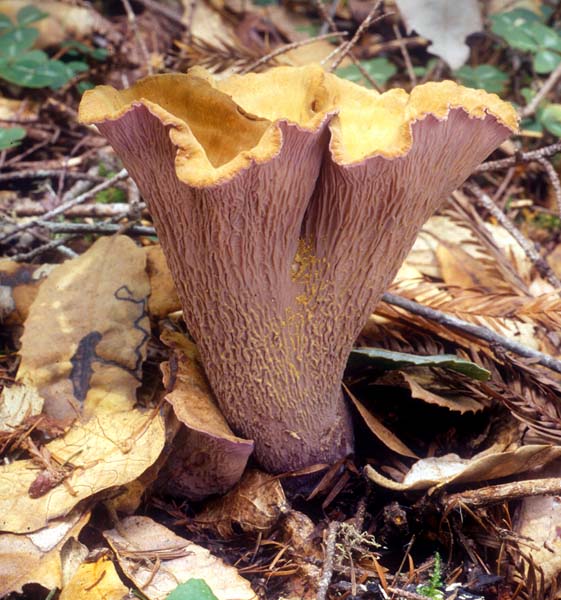Even In A Fallen State We Eat From The Hand Of God
FALL FOOD FROM GOD

Gomphus clavatus
Nat Arr. Brit. Pl. 1: 638. 1821.
Common Name: Pig's Ears
Even Alexis Lavrentivitch Ignatius Eldred Williams will eat these.
Synonym: Cantharellus clavatus Fries
- Pileus
Caps up to 10 cm broad, at first clavate, the apex truncate, expanding to form a vase-shape fuiting body, one side typically showing greater developement than the other; margin undulate to lobed, upturned in age; surface moist, soon dry, smooth to finely squamulose, especially near the disk, the latter often depressed; lavender-purple to purple-brown when young, fading to buff-brown in age, the margin sometimes retaining lilac tones; flesh thick, white to pale buff; odor and taste mild, of mushrooms.
- Hymenium
Fertile surface decurrent, varing from blunt, interconnecting ridges to anastamosing veins, and wrinkles, occasionally nearly poroid; lilac-purple to purple-brown fading in age.
- Stipe
Stipe up to 5 cm long, 1-3 cm thick, short, solid, sometimes hollow at maturity, central to laterally attached, tapering downward, the apex merging with and indistinguishable from the hymenium/cap; often fused at the base with adjacent fruiting bodies; surface slightly fibrillose to hairy, lilac-brown apically, white to pale brown below; flesh white, unchanging.
- Spores
Spores 10-14 x 5-7.5 µm, elliptical, wrinkled to slightly warted, nonamyloid; pale yellowish-buff in deposit.
- Habitat
Singly, in cespitose clusters and arcs under conifers; fruiting from late fall to mid-winter.
- Edibility
 Described as edible and choice by some authors, but usually regarded as mediocre locally; often infested with fly larva.
Described as edible and choice by some authors, but usually regarded as mediocre locally; often infested with fly larva. - Comments
Gomphus clavatus is characterized by a clustered habit, lilac-colored, wrinkled hymenium and club-shaped to partially funnel-shaped fruiting body. The lilac color easily distinguishes it from Gomphus floccosus f. floccosus and G. bonari.
- References
Corner, E.J.H. (1966). A Monograph of Cantharelloid Fungi. Oxford University Press: London, England. 255 p.
Giachini A. (2004). Systematics, Phylogeny, and Ecology of Gomphus sensu lato. Ph.D. Dissertation. Oregon State University: Corvalis, OR. 446 p.
Smith, A.H. (1949). Mushrooms in their Natural Habitats. Sawyer's Inc: Portland, OR. 626 p.
Smith, A.H. & Morse, E.E. (1947). The genus Cantharellus in the western United States. Mycologia 39(5): 497-534.
Thiers, H.D.(1985). The Agaricales (Gilled Fungi) of California. 3. Gomphidiaceae. Mad River Press: Eureka, CA. 20 p.
Watling, R. & Turnbull, E. (1998). British Fungus Flora: Agarics and Boleti. Vol 8. Cantharellaceae, Gomphaceae, and Amyloid-Spored and Xeruloid Members of Tricholomataceae (excl. Mycena). Royal Botanic Garden: Edinburgh, Scotland. 189 p. - Other Descriptions and Photos
- Boleslaw Kuznik: Gomphus clavatus (CP)
- Boleslaw Kuznik: Gomphus clavatus (CP)
- Michael Wood: Gomphus clavatus (CP)

- Boleslaw Kuznik: Gomphus clavatus (CP)
- Handbook to Additional Fungal Species of Special Concern in the Northwest Forest Plan: Gomphus clavatus (D & CP)
- Boleslaw Kuznik -- Hunting for Mushrooms: Gomphus clavatus (CP)
- Il Mondo dei Funghi: Gomphus clavatus (D & CP)
- Svampbok: Gomphus clavatus (D & CP)
- Mushroom Observer: Gomphus clavatus (CP)
- Arora (1986): p. 661 (D), plate 176
- Arora (1991): p. 7 (D & CP)
- Breitenbach & Kränzlin (vol. 2): sp. 480 (D, I, & CP)
- Lincoff: p. 396 (D), plate 440 (CP)
- McKenny et al.: p. 28 (D), p. 29 (CP)
- Miller: sp. 265 (D & CP)
- Phillips: p. 212 (CP), p. 213 (D)
- Smith & Weber: sp. 55 D & CP) [Cantharellus clavatus]
- Thiers (1985): p. 22 (D)


